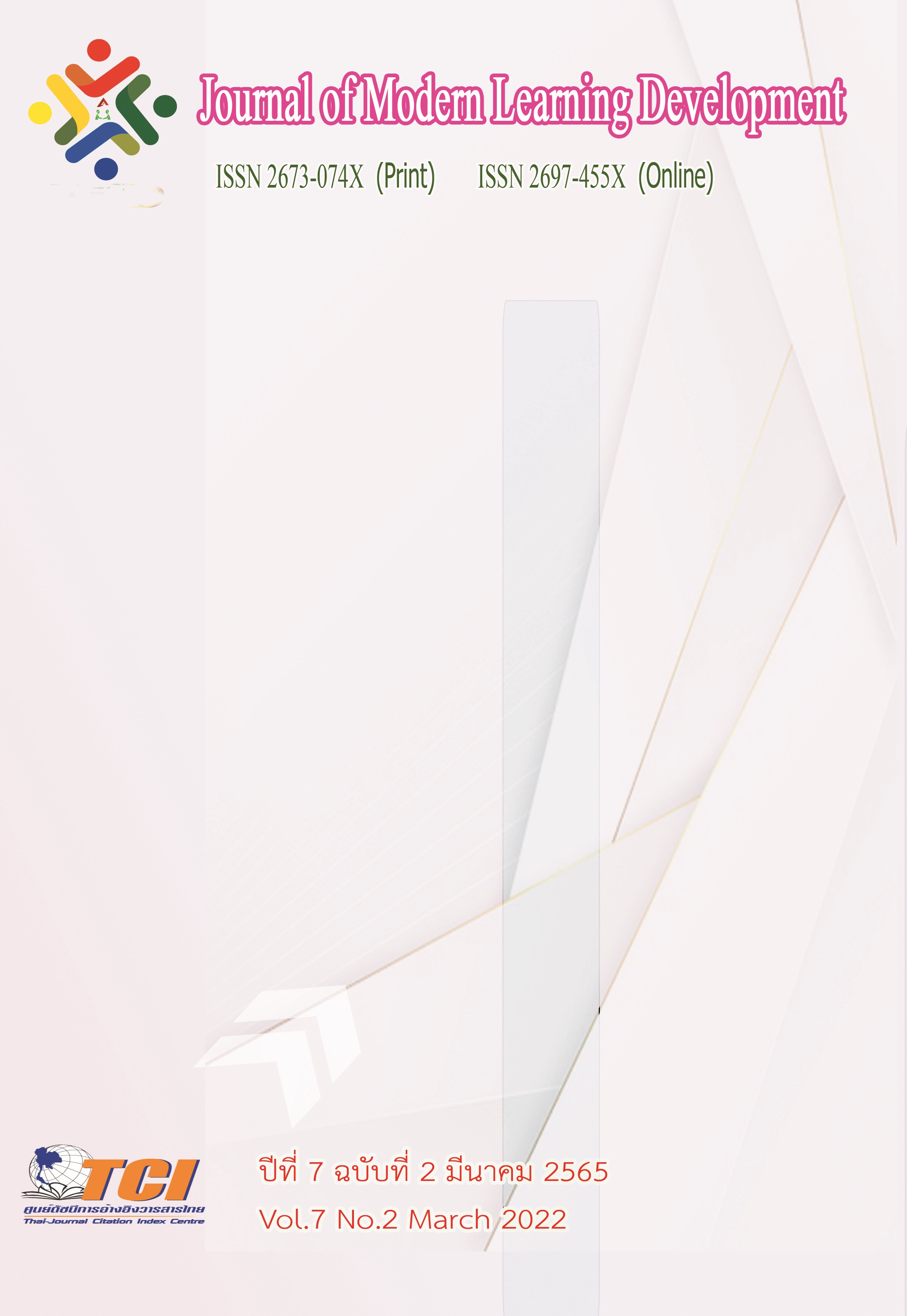การเปรียบเทียบผลสัมฤทธิ์ทางการเรียน วิชาสังคมศึกษา เรื่อง หลักธรรมค้ำจุนโลก ของนักเรียนชั้นประถมศึกษาปีที่ 5 ระหว่างการสอนโดยใช้ อินโฟกราฟิกกับการสอนแบบปกติ
Main Article Content
บทคัดย่อ
การวิจัยครั้งนี้เป็นการวิจัยเชิงทดลอง มีวัตถุประสงค์ คือ 1.) เพื่อสร้างและหาประสิทธิภาพของสื่ออินโฟกราฟิก วิชาสังคมศึกษา เรื่อง หลักธรรมค้ำจุนโลก ของนักเรียนชั้นประถมศึกษาปีที่ 5 ให้เป็นสื่อที่มีประสิทธิภาพตามเกณฑ์มาตรฐาน 80/80 2.) เพื่อเปรียบเทียบผลสัมฤทธิ์ทางการเรียนวิชาสังคมศึกษา เรื่อง หลักธรรมค้ำจุนโลกของนักเรียนชั้นประถมศึกษาปีที่ 5 ระหว่างการสอนโดยใช้อินโฟกราฟิกกับการสอนแบบปกติ 3.) เพื่อศึกษาความพึงพอใจของนักเรียนที่มีต่อการใช้อินโฟกราฟิกวิชาสังคมศึกษาเรื่อง หลักธรรมค้ำจุนโลก ของนักเรียนชั้นประถมศึกษาปีที่ 5 ใช้เครื่องมือการวิจัย คือ 1) อินโฟกราฟิก วิชาสังคมศึกษา เรื่อง หลักธรรมค้ำจุนโลก 2) แผนการจัดการเรียนรู้3) แบบทดสอบวัดผลสัมฤทธิ์ทางการเรียน และ4) แบบสอบถามความพึงพอใจของนักเรียนต่อการสอนโดยใช้อินโฟกราฟิกกลุ่มตัวอย่างการวิจัยประกอบด้วย กลุ่มทดลองนักเรียนชั้นประถมศึกษาปีที่ 5 โรงเรียนวัดแคจังหวัดสมุทรปราการ จำนวน 15 คน ใช้วิธีการสอนโดยใช้ อินโฟกราฟิก เรื่อง หลักธรรมค้ำจุนโลก และกลุ่มควบคุมนักเรียนชั้นประถมศึกษาปีที่ 5 โรงเรียนวัดหลักสองราษฎร์บำรุง จังหวัดสมุทรสาคร จำนวน 15 คน ใช้วิธีการสอนแบบปกติ
ผลการวิจัยพบว่า
1) ผลการหาประสิทธิภาพอินโฟกราฟิก วิชาสังคมศึกษา เรื่อง หลักธรรมค้ำจุนโลกของนักเรียน ชั้นประถมศึกษาปีที่ 5 มีประสิทธิภาพเท่ากับ 80.50/80.58 ซึ่งสูงกว่าเกณฑ์ที่กำหนดไว้ตามเกณฑ์มาตรฐาน 80/80
2) ผลสัมฤทธิ์ทางการเรียนของนักเรียนชั้นประถมศึกษาปีที่ 5 วิชาสังคมศึกษา เรื่อง หลักธรรม ค้ำจุนโลก ระหว่างการสอนโดยใช้อินโฟกราฟิกกับการสอนแบบปกติ แตกต่างกันอย่างมีนัยสำคัญทางสถิติที่ระดับ .05
3) ผลการศึกษาความพึงพอใจนักเรียนชั้นประถมศึกษาปีที่5 โรงเรียนวัดแคที่มีต่อสื่ออินโฟกราฟิก เรื่อง หลักธรรมค้ำจุนโลก พบว่า นักเรียนมีความพึงพอใจต่อการเรียนด้วยสื่ออินโฟกราฟิกอยู่ในระดับมากที่สุด มีคะแนนค่าเฉลี่ยเท่ากับ 4.70 และส่วนเบี่ยงเบนมาตรฐานเท่ากับ 0.15
Article Details
เอกสารอ้างอิง
กระทรวงศึกษาธิการ. (2551). หลักสูตรแกนกลางการศึกษาขั้นพื้นฐาน พุทธศักราช 2551. กรุงเทพมหานคร:โรงพิมพ์คุรุสภาลาดพร้าว.
จงรัก เทศนา. (2557). อินโฟกราฟิก (Infographics). ออนไลน์, สืบค้นเมื่อ 12 มิถุนายน2564. แหล่งที่มา: http://www.thinkttt.com/wpcontent/uploads/2014/04/how_to_infographics2.pdf
ปวันรัตน์ ศรีพรหม. (2562). การพัฒนากิจกรรมการเรียนรู้โดยใช้บริบทเป็นฐานร่วมกับอินโฟกราฟิกเพื่อส่งเสริมการรู้เรื่องวิทยาศาสตร์และเจตคติต่อวิทยาศาสตร์เรื่อง พันธะเคมีสำหรับนักเรียนชั้นมัธยมศึกษาปีที่ 4. วิทยานิพนธ์การศึกษามหาบัณฑิต สาขาวิชาหลักสูตรและการสอน. บัณฑิตมหาวิทยาลัย: มหาวิทยาลัยนเรศวร.
พนมวรรณ ผลสาลี่. (2561). การพัฒนาสื่ออินโฟกราฟิกตามทฤษฎีการถ่ายโยงความรู้เรื่องการออมเพื่ออนาคต สำหรับนักเรียนขั้นประถมศึกษาปีที่ 6. วิทยานิพนธ์ปริญญาศึกษาศาสตรมหาบัณฑิต สาขาเทคโนโลยีและการสื่อสารการศึกษาคณะครุศาสตร์อุตสาหกรรม. บัณฑิตมหาวิทยาลัย: มหาวิทยาลัยเทคโนโลยีราชมงคลธัญบุรี.
วิทย์ วิศทเวทย์และเสถียรพงษ์วรรณปก. (2560). หนังสือเรียนสาระการเรียนรู้พื้นฐานกลุ่มสาระการเรียนรู้สังคมศึกษา ศาสนาและวัฒนธรรม ป.5. กรุงเทพมหานคร: อักษรเจริญทัศน์.
วราภรณ์ พรมนิล. (2560). ปัจจัยการบริหารที่ส่งผลต่อผลลัพธ์ของโรงเรียนมัธยมศึกษาในโครงการโรงเรียนมาตรฐานสากล สังกัดสำนักงานศึกษาธิการจังหวัดปทุมธานี. ศึกษาศาสตรมหาบัณฑิต สาขาการบริหารการศึกษา คณะครุศาสตร์อุตสาหกรรม. บัณฑิตวิทยาลัย: มหาวิทยาลัยเทคโนโลยีราชมงคลธัญบุรี.
สุภาพร นะมามะกะ. (2562). การพัฒนาสื่อการสอนอินโฟกราฟิกแบบภาพนิ่งเพื่อพัฒนาผลสัมฤทธิ์ทางการเรียนของนักเรียนชั้นมัธยมศึกษาปีที่1. ออนไลน์. สืบค้นเมื่อ 14 มิถุนายน 2564. แหล่งที่มา: https://so01.tcithaijo.org/index.php/ectstou/article
ยุวรี อยู่เจริญ. (2564). การพัฒนาสื่ออินโฟกราฟิกรายวิชาการงานอาชีพและเทคโนโลยีระดับประถมศึกษา ปีที่ 1. ออนไลน์. สืบค้นเมื่อ 14 มิถุนายน 2564.. แหล่งที่มา: https://so01.tcithaijo.org/index. php/The_New_Viridian/article/view/24612
Lam Ky Nhan. (2021). The impact of using infographics to teach grammar on EFL students’ learning motivation. European Journal of Foreign Language Teaching, 5 (5), 85 – 102.
Taner Çifçi. (2016).Effects of Infographics on Students Achievement and Attitudetowards Geography Lessons. Journal of Education and Learning; 5 (1). 154 – 166


